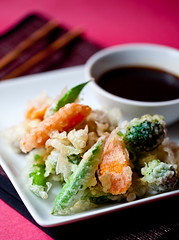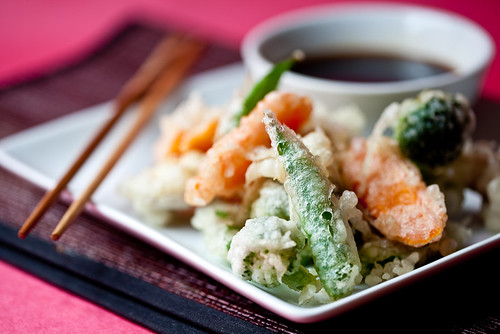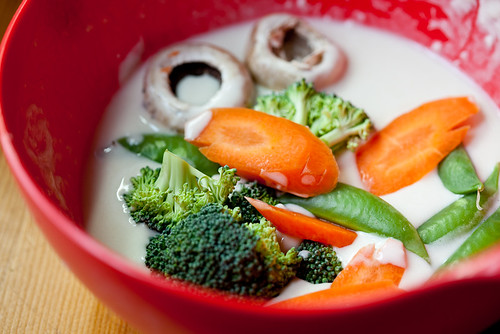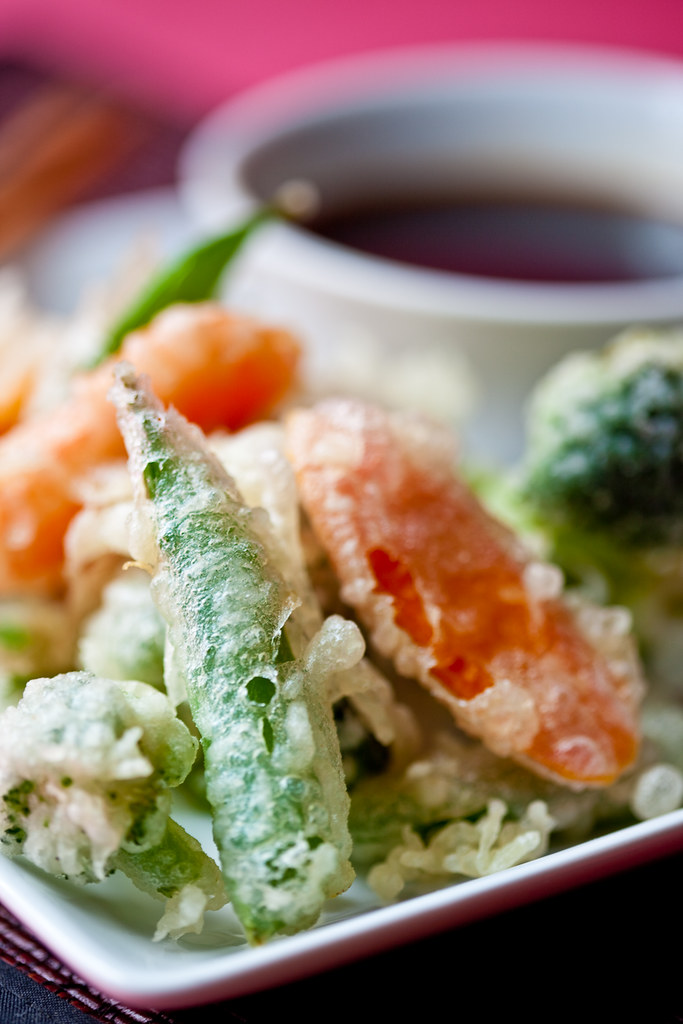Vegetable Tempura
I really love vegetable tempura, but it often the batter contains eggs, so I have to skip it when I’m eating at a japanese restaurant. But it’s really easy to make eggless tempura at home. You can absolutely pick up a box mix of “tempura powder” at a local asian market and skip the egg the directions call for — even the box says it’s optional. Or, you can use this recipe and make your own batter from scratch.
When you see “serve immediately” at the bottom of this recipe, I’m not kidding. You want to have absolutely everything set and everyone ready to eat when the veggies come out of the oil. As the veggies cool, the once crispy breading will begins to soften, leaving you with soggy tempura. No fun. So make sure you have your place settings, your dipping sauce, and your friends or family ready to go once the veggies hit the oil.
The oil temperature needs to be 180º C or 350º F. If you add a lot of veggies to the oil at once, not only will they stick together (not so bad), but the oil temperature will drop like a rock (very bad). Tempura fried at too low a temperature will never become crispy. It’ll cook, but it’ll be a soft, heavy coating instead of a light, crispy one.
 How can you tell if your oil is hot enough? When you drop a batter coated veggie in, little bits of batter will explode off the veggie outward like tempura fireworks. These bits, called tenkasu, are a good indication that your batter is hot enough. The veggies should cook for 40 seconds to 1 minute and feel crispy when you knock them around. You don’t need them to be golden brown, so don’t wait for that.
How can you tell if your oil is hot enough? When you drop a batter coated veggie in, little bits of batter will explode off the veggie outward like tempura fireworks. These bits, called tenkasu, are a good indication that your batter is hot enough. The veggies should cook for 40 seconds to 1 minute and feel crispy when you knock them around. You don’t need them to be golden brown, so don’t wait for that.
Most vegetables will cook to the perfect tenderness in that time, including harder ones like carrots if you keep their width to 1/4″ thick. For harder vegetables like squash or sweet potatoes, you may want to briefly blanch them to get them going before frying. But broccoli, mushrooms, and green beans or snap peas don’t require any pre-cooking at all.
I recommend a traditional tentsuyu dipping sauce for these. My recipe is a little different than the ones you find online, but it’s my favorite.
Vegetable Tempura
Serves 2-4
1 Liter Vegetable Oil, for frying
1 Stalk Broccoli, florets only
2 Carrots, sliced on the bias, 1/4″ thick
1 Cup Mushrooms, your favorite
1 Cup Sugar Snap Peas or Green Beans
(Feel free to use any vegetables you like!)
Tempura Batter
1 Cup Cold Water (very cold!)
1 Cup Flour
2 Pinches Salt
1/4 tsp Baking Powder
1 Tbs Ener-g Egg Replacer Powder mixed with 3 Tbs Water
1/4 Cup Extra Water, if needed, for thinning
Tentsuyu Dipping Sauce
1/4 Cup Vegetable Stock, or Dashi if you have it
1 Tbs Sugar
1/4 Cup Low Sodium Tamari
1 Tbs Rice Vinegar
1/4 Cup Water
Heat all the sauce ingredients in a small pan until the sugar is dissolved. Set aside to cool.
Chop your vegetables, making sure harder vegetables like carrots are no more than 1/4″ thick if frying raw. Blanch vegetables like squash or sweet potatoes, if using.
Heat your oil to 350º F. A little bit of batter dropped into the oil should float to the surface immediately, and little bits of batter should explode off the veggies when frying.
Dip your vegetables in the batter.
Drop an assortment of battered vegetables into the oil, being careful not to overcrowd. You may need to turn up the temperature of the oil, because the vegetables will cool it.
Fry for 40 seconds to 1 minute until very crispy and light. Drain on a paper towel for a few seconds.
Serve immediately with dipping sauce and/or salt and pepper.




Delicious!
What oil is good for going up to 350° without burning? What’d you use?
Do you have to take out the bits of batter after you’ve fried some veggies to keep the bits from burning?
I used canola oil, which I know lots of people don’t like. I think safflower oil or peanut oil would also work!
If i ain’t wrong, there is fish in Dashi. Which is a japanese fish powder, as far as I know.
Dashi is a vegetable stock made with seaweed. Some people add bonito, too, which is fish flakes, but obviously you’d leave that out if you’re veg*n! :)
Ah, another vegan blog not afraid to show some fried food from time to time! I love it.
I love tempura, but I haven’t tried making them at home – I tend to shy away from deep frying anything. Your pictures are inspiring me to go for it, though!
I usually use just flour and water- I’ll add baking powder next time!
That looks delicious! This is the second post I have seen this week for vegan tempura, but the other was gluten-free.
I love how see-through your batter is! Its beautiful! I’ve only had tempura in restaurants and the batter is always so thick, you can’t tell what’s what.
Woah! Beautiful veggies =)
Wow, these look so tasty! Whenever I try to fry something, I inevitably burn myself, but after seeing these pictures, I really want to give it another go!
oh i love tempura veggies so much!!
Wow, it looks good. I’ve never heard of a veggie tempura before. Will give it a try
Thanks for making tempura accessible to everyone! It was always so mysterious to me…
And that last photo is gorgeous!
:)
Looks good!
The only reason I’ve never made tempura is I don’t know what to do with the used oil afterwards. They always say don’t put it down the drain, and it’s an awful lot to put in the trash can. What do you do with your?
Thanks!
J
Oh, I love vegetable tempura, but I’ve never made it on my own – I’ll have to give it a try!
I haven’t ventured into tempura making yet, but this has me very intrigued!
Thanks for the education in tempura. This looks like a great recipe to try some weekend.
Wow, your tenpura looks so professional and scrumptious! Definitely a great way to get your vegetables. By far my favorite tenpura vegetable is taro root :D
I love tempura! Yours looks so good! :-)
i love that there’s a word in japanese for ‘the little bits of batter that explode off the tempura veggie’. awesome! i remember my mum making amazing tempura but she wouldn’t do it very often because it meant she was kinda chained to the stove. i’ve made it a couple of times but they never crisped up nicely – i now know it was because the oil wasn’t hot enough
Really gorgeous! I love tempura, especially the green beans!
I lived in Japan for some years. This tempura looks delicious. On the dashi issue- prepared dashi (for example dashi no moto pellets- similar to bullion) that you might buy would ALWAYS, always, always contain katsuobushi or dried bonito (fish products). However, it is possible to make homemade vegan/vegetarian dashi. I’ve seen English language recipes (and used them) using konbu (seaweed) and roasted soybeans, for example, but this is not typically a recipe you’d find in most traditional Japanese cookbooks. I don’t know any Japanese home cooks that would make dashi without the above-mentioned fish products. Unfortunately, vegetarianism is rather uncommon in Japan, and most monks in Japan both marry and eat meat- temples were one place you might have originally expected to find a vegetarian dashi. The dashi issue is also one of the things making it so difficult to eat truly vegetarian in Japanese restaurants. :( So, it might be clearest to specify vegetarian dashi in the recipe, even though no would would actually think you used a non-veg dashi.
BTW I really love your blog, and we couldn’t get enough of your sweet and sour tofu when we tried it the other night!
Oh, and if anyone wants it- Just Hungry is one of my favorite Japanese expat bloggers and she has a very nice recipe for vegetarian/vegan dashi that I thought might be useful for those wanting to make it.
http://www.justhungry.com/vegetarian-dashi-japanese-stock
(Not my blog! I’m just a fan. lol)
-Sea
my favorite thing to tempura is an entire sushi roll (before it gets cut up.) yum.
Good one. But no good for the Underground restaurant unless I have a week with few people.
I know religiously make my own vegetable stock every week thanks to you.
now that should read
Looks really light and crispy! A healthy tempura indeed!
Tempura and tempura sauce are delicious!! I just don’t like the idea of frying…But hey, for once in a while…
This looks delicious! Thanks for the recipe
How fresh and delicious looking!
Cheers
@15 — at many Asian markets, you will find kitchen supplies; frequently among them you will see a little tin pitcher with a screen over the top, that you can pour your used cooking oil into, filtering out the food bits to discard, so that you can reuse your cooking oil. Of course, to make your own, any metal pitcher with a lid will do, just pour your oil through a mesh sieve.
Oh this is exactly what I want to be eating right now! Love truly great tempura. The Red Cat in New York makes a great side of tempura green beans during the summer…my mouth is watering just thinking about it!
Fried Foods is de rigueur: it’s Mardi Gras on Tuesday!
That is some beautiful tempura! I love tempura, and I’m heading out for some Japanese food this week. I’ll definitely be ordering some now! I’m a bit too afraid of deep frying at home to try it out myself.
Mmmm… I love tempura, I’m going to have to make this in the near future. I made sweet potato tempura a few years back and was SO good.
Mmmmm, I love tempura but I’ve never made it myself, I’ll have to try this at some point!
Hi,First time to ur blog and liked ur space.I love veg tempura,never knew abt the tempura powder.The next time i will surely look for one.Wonderful recipe.
I’ve tried making veggie tempura at home with varying results, so I appreciate your instructions and recipe – the results look fantastic!
wow your blog is amazing :)
delicious recipes and beautiful photos
“bravissima”
ciao from Italy
eli
I am drooling! It’s 8am, but I want tempura more than anything now!
what kind of oil did you use with such high temperature without burning?
btw, I’ve sent you email.. hope you got it
cheers,
sefa
Mmmmm, we love tempura fried veggies. We don’t eat fried foods very often because it tends to upset our stomachs, but the veggies are so much lighter than meat that it works out nicely. Red onions, bell peppers, and mushrooms are my favorites.
I did a ton of experiments regarding tempura batter a while ago. They never came out as beautiful-looking as yours.
Anyways, my main findings were (1) keeping a couple of ice-cubes in the batter when you’re cooking helps (2) (as I’m sure you already know) beer makes a really nice, light batter, as an alternative to baking soda.
this blog is amazing!
I love tempura! ñam ñam!
What a beautiful blog! Your photos have made my tummy rumble so I’m off to the kitchen…
Is there a vegan dashi broth that I don’t know about?
I make my own dashi with kombu. I also add tamari, and sometimes mirin. I leave out the fish flakes, obviously. :)
You should try tempura-ing some herbs and greens. We had some garden overgrowth a couple of years ago and did mint, basil, parsley, mustard greens, kale, sooo good!